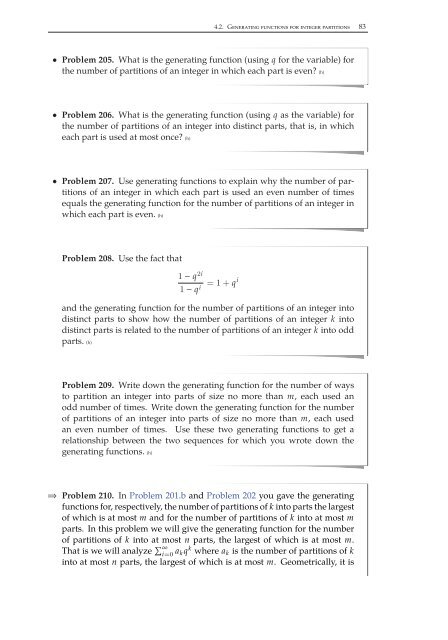Combinatorics Through Guided Discovery, 2004a
Combinatorics Through Guided Discovery, 2004a
Combinatorics Through Guided Discovery, 2004a
Create successful ePaper yourself
Turn your PDF publications into a flip-book with our unique Google optimized e-Paper software.
4.2. Generating functions for integer partitions 83<br />
• Problem 205. What is the generating function (using q for the variable) for<br />
the number of partitions of an integer in which each part is even? (h)<br />
• Problem 206. What is the generating function (using q as the variable) for<br />
the number of partitions of an integer into distinct parts, that is, in which<br />
each part is used at most once? (h)<br />
• Problem 207. Use generating functions to explain why the number of partitions<br />
of an integer in which each part is used an even number of times<br />
equals the generating function for the number of partitions of an integer in<br />
which each part is even. (h)<br />
Problem 208. Use the fact that<br />
1 − q 2i<br />
1 − q i =1+q i<br />
and the generating function for the number of partitions of an integer into<br />
distinct parts to show how the number of partitions of an integer k into<br />
distinct parts is related to the number of partitions of an integer k into odd<br />
parts. (h)<br />
Problem 209. Write down the generating function for the number of ways<br />
to partition an integer into parts of size no more than m, each used an<br />
odd number of times. Write down the generating function for the number<br />
of partitions of an integer into parts of size no more than m, each used<br />
an even number of times. Use these two generating functions to get a<br />
relationship between the two sequences for which you wrote down the<br />
generating functions. (h)<br />
⇒<br />
Problem 210. In Problem 201.b and Problem 202 you gave the generating<br />
functions for, respectively, the number of partitions of k into parts the largest<br />
of which is at most m and for the number of partitions of k into at most m<br />
parts. In this problem we will give the generating function for the number<br />
of partitions of k into at most n parts, the largest of which is at most m.<br />
That is we will analyze ∑ ∞<br />
i=0 a kq k where a k is the number of partitions of k<br />
into at most n parts, the largest of which is at most m. Geometrically, it is


















